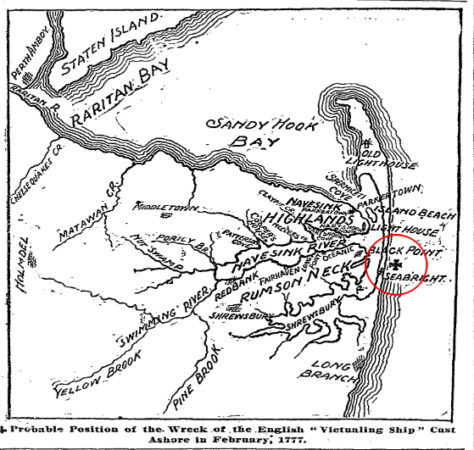On February 13, 1777, the militia of Monmouth County suffered “most severely” in an engagement known as the Battle of the Navesink, which took place in the area that is now Rumson and Highlands, and Sea Bright.
Particularly during the winter months, both the British and Continental armies were in need of food, and New Jersey was the constant scene of skirmishes and battles between the militia and foraging parties sent out by the British from Sandy Hook and Staten Island.
About the 1st of February, 1777, a severe snowstorm swept over the region. During the storm, an English “victualizing ship” carrying provisions, and a captured French captain, “was cast ashore on Sandy Hook,” near Sea Bright (see map above). Militia stationed in Rumson crossed over to Sea Bright, placed a guard around the ship, and effected the escape of the French captain. Additional militia began to muster in Highlands to assist in taking possession of the ship and its cargo. Loyalists witnessed this and immediately had word sent to British General William Howe on Staten Island.
Howe assembled an invasion force comprised of 170 men from the 26th (Cameronian) Regiment of Foot, a Scottish infantry regiment of the British Army, along with a number of men from the 2nd Battalion, New Jersey Volunteers, Monmouth County loyalists. Included among these were a number of escaped slaves who had taken up arms for the King in return for a promise of freedom. These locals were recruited by John Morris and were stationed on Staten Island, working in conjunction with the 26th Regiment. The strength of the 2nd Battalion, New Jersey Volunteers, was estimated to be as much as 300 men at one point. It is not known how many participated in this battle. These two units joined a company of Royal Marines aboard HMS Syren, a 28-gun frigate, that completed the invasion force.
In the darkness of the early morning, the invaders came ashore at Rumson, guided by local Loyalists who knew well the “shoals and channels” of the Shrewsbury River area. The militia were caught by surprise, some still asleep. They had come from different nearby towns, and were unaccustomed to fighting as a cohesive unit, and were no match for the well-trained British regulars and their more-practiced civilian supporters. When the invasion force headed back to Staten Island, they left behind 25 dead militiamen, and took 72 prisoners with them. The British did not consider captured Patriots to be prisoners-of-war, and treatment for those taken prisoner was extremely harsh, and often fatal. In fact, more Americans died in British prisons during the Revolutionary War than on battlefields, especially those misbegotten souls who ended up in the British hulks, the prison ships, where conditions were beyond squalid and deadly.
The primary source for this event comes from a story on the front page of the Sunday New York Times over the signature of “M.C.M. Hyde,” that appeared on February 23, 1896, almost 120 years after the battle took place. In his article, the author asserts that “It seems strange that little, if anything, should generally be known of such an engagement, in which 25 men were killed and 72 taken prisoners.” But the Times story is based on actual Monmouth County pension records and other first-hand accounts, and has been confirmed by author and historian Michael Adelberg in his book, “The Revolutionary War in Monmouth County.” Mr. Adelberg’s take on this event is that, owing to its one-sided outcome, it should be more accurately known as “The Monmouth Massacre.”
Text and Image Sources:
Hyde, M.C.M. (1896). Battle of the Navesink. The New York Times, February 23, 1896, P. 1. Available: https://highlandsnj.com/history/assets-StoryOfHighlands/BATTLE_OF_THE_NAVESINK_1777.pdf
Adelberg, Michael S. (2010). The American Revolution in Monmouth County: The Theatre of Spoil and Destruction. The History Press, Charleston, S.C.
Home


Leave a Reply